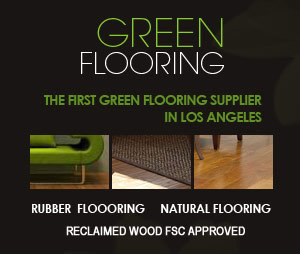902 S. Barrington Ave.
Los Angeles, CA 90049
310-826-8063
1888 S. Sepulveda Blvd.
Los Angeles, CA 90025
310-837-8110
A Quick Guide to Bamboo Floor Installation Preparation
 Thanks to its renewability and sustainability, bamboo flooring has given homeowners everywhere a green flooring alternative to traditional hardwood floors. Every bit as durable and attractive as solid wood, bamboo continues to enjoy a rise in popularity as more and more people become environmentally aware. In some instances, homeowners may be able to perform their bamboo flooring installation themselves, creating a pride in not only the type of floor they’ve chosen, but also in their personal craftsmanship.
Thanks to its renewability and sustainability, bamboo flooring has given homeowners everywhere a green flooring alternative to traditional hardwood floors. Every bit as durable and attractive as solid wood, bamboo continues to enjoy a rise in popularity as more and more people become environmentally aware. In some instances, homeowners may be able to perform their bamboo flooring installation themselves, creating a pride in not only the type of floor they’ve chosen, but also in their personal craftsmanship.
Tips on Getting the Best Results Out of Bamboo Hardwood Flooring
A bamboo floor installation can be easy, thanks to the way bamboo flooring is manufactured. Easy-to-follow instructions that are available make bamboo floor installation even more straightforward. There are three methods that can be followed when going forward with bamboo floor installation.
Types of Bamboo Flooring Installations:
Nailed or Stapled – this is the type of installation you do if you have a wooden subfloor because the bamboo hardwood flooring is directly fastened to the subfloor.
Glue-down – as the name suggests, a glue-down bamboo floor installation involves gluing the bamboo hardwood flooring to the subfloor. Gluing down flooring is very easy, making glue-down bamboo floor installation doable for DIY enthusiasts.
For the glue-down type of installation to work DIY style, one must follow instructions and make sure to use the right type of adhesive.
Preparing the Subfloor for a Bamboo Installation
As with most floor installations, the subfloor is an important part of bamboo floor installation. The subfloor must be dry and even. It should also be free from debris such as sand, dust, exposed nail heads, and old staples. These preparations are done to make sure that your bamboo floor installation lies flat on the surface.
Obstructions below the floor board will result in cracks or breakage on the floor surface. Moisture that is left unchecked on the subfloor may also damage your bamboo floor installation. The moisture coming from the subfloor may make the bamboo floor buckle and swell over time.
Acclimatizing the bamboo hardwood flooring is a very important step which allows the boards to adjust to changes in its environment – temperature or moisture levels. The bamboo hardwood flooring must be exposed and left for 48 hours for maximum success. When this process is missed, you risk having your poor-fitting bamboo hardwood flooring that shrink and swell with changes in temperature and humidity after it is installed. This makes for a less stable floor.
Check Out Your Bamboo Boards
One other thing to do is to check the boards for color, grade, finish, and quality. Check for damage and defects before you starting on your bamboo floor installation. One must not lay down defective floor boards, and the warranty is void if the damaged or defective floor boards are already installed.
Measure the Space Before Beginning the Bamboo Floor Installation
When you are ready to do your bamboo floor installation, one of the first things you do is to measure the room correctly and lay out the bamboo flooring in a “dry run”. Do this prior to actually installing the boards to see how the installation is going to look like once it is bonded to the subfloor. This will help you determine the placement of each board, keeping in mind its color, grain, and other pertinent features.
May
Log in to post a comment.


Comment